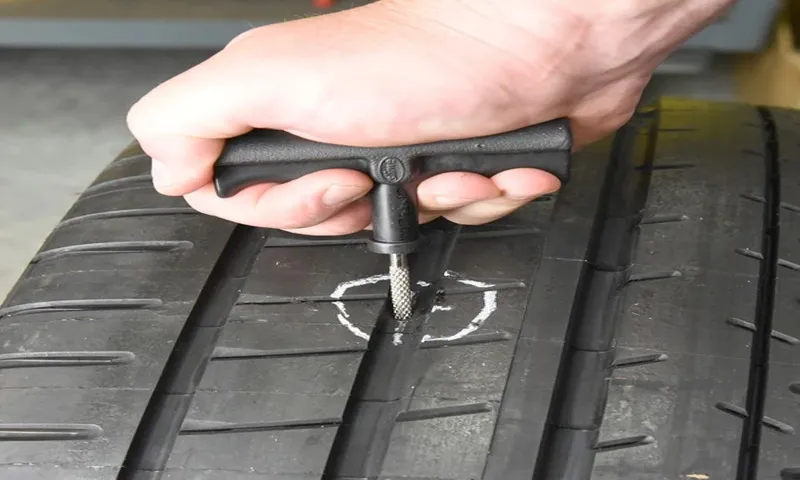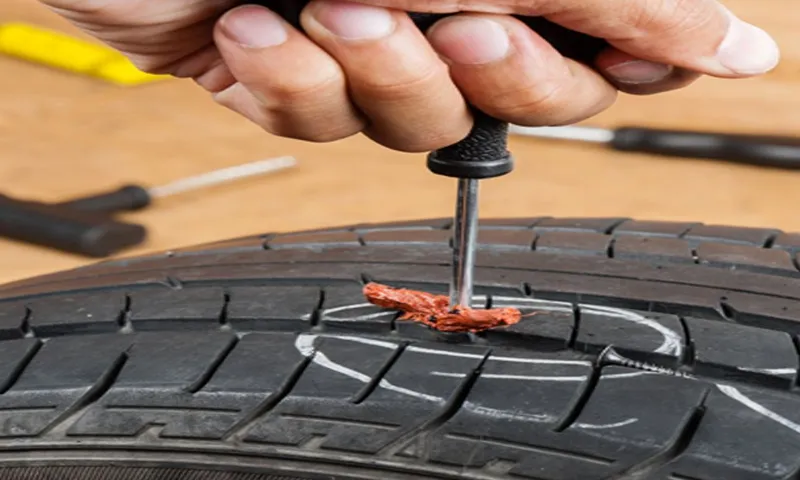Have you ever been stranded on the side of the road with a flat tire? It’s a frustrating and stressful experience. But with a bit of know-how, fixing a tire puncture can be a simple and quick task. In this step-by-step guide, we’ll walk you through the process of fixing a tire puncture so that you can hit the road again in no time.
First, you’ll need to remove the tire from your vehicle. Once the tire is removed, inspect it closely to locate the puncture. This can be done by feeling around the tire for any objects that may be stuck in it or by using a solution to locate the leak.
Once you’ve located the puncture, use a tire plug or a patch kit to repair the tire. This involves inserting a plug into the hole or applying a patch over the puncture site. After the puncture has been repaired, you’ll need to re-inflate the tire to the recommended pressure.
You can do this using a tire inflator or a compressor. Be sure to check the pressure with a tire gauge to ensure it’s at the proper level. Finally, re-install the tire onto your vehicle and perform a quick test drive to ensure everything is working properly.
With these simple steps, you can confidently handle a tire puncture and get back on the road with ease.
Table of Contents
Assess the Damage
When you have a tire puncture, the first step is to assess the damage. Check to see if the puncture is in the tread, sidewall, or shoulder of the tire. If the puncture is in the tread, it may be possible to repair the tire.
However, if the puncture is in the sidewall or shoulder, the tire will need to be replaced. Next, check the size and depth of the puncture. If the hole is less than a quarter-inch in diameter and not too deep, it may be possible to repair the tire with a patch kit.
However, if the damage is more severe, you may need to take the tire to a professional to be replaced or repaired. It is important to address tire punctures promptly to ensure safe driving conditions for you and your passengers. By assessing the damage and determining the best course of action, you can avoid further damage to your tire and keep your vehicle running smoothly.
Locate the Puncture
When you find yourself with a flat tire, your first step is to locate the puncture. This is crucial in order to properly assess the damage and decide on the best course of action. Start by examining the tire carefully, looking for any visible punctures or objects stuck in the rubber.
If you can’t find anything, try spraying the tire with soapy water and looking for bubbles or leaks. Once you’ve located the puncture, you can determine if it’s small enough to be repaired or if the tire needs to be replaced. Remember, it’s always better to err on the side of caution and replace the tire if there’s any doubt about its safety.
By taking the time to assess the damage and make a careful decision, you can get back on the road with confidence and peace of mind.

Check the Tire’s Condition
One of the most important things to check before hitting the road is the condition of your vehicle’s tires. While assessing the damage may sound daunting, it can be easily done with a few simple steps. Start by checking the tread on each tire to ensure they are not worn down or bald, as this can cause your car to slide or lose traction on wet or slippery roads.
Look for any cuts or punctures on the tires, which can lead to air leakage and, ultimately, a flat tire. Additionally, check the tire pressure regularly, as underinflated tires can affect your vehicle’s handling and fuel efficiency. By taking the time to assess your tires’ condition, you can ensure a safer and smoother journey on the road.
Don’t neglect your tires – they are your car’s only contact with the road, for your safety’s sake!
Remove the Tire
Now that you’ve identified the puncture in your tire, it’s time to take it off and get to work. First, loosen the lug nuts of the affected tire while ensuring the vehicle is in park and using an appropriate wrench size. Once you’ve done that, use a jack to lift the car and remove the tire completely.
Be sure to place the tire you’ve removed in a safe place so it doesn’t roll away or get damaged. Keep in mind that if you have a spare tire, you’ll need to get that ready now and ensure that it’s in good condition. With the tire removed, you can now inspect the puncture more closely and decide on the best course of action to fix it.
Remember to stay safe, take your time, and don’t rush the process to avoid any injuries or further damage to your vehicle. By following these steps, you’ll be well on your way to fixing your punctured tire and getting back on the road in no time.
Remove the Wheel
Once you have lifted the car and removed the lug nuts, it’s time to remove the tire. But where do you start? The first step is to take hold of the tire and give it a good tug. If it’s stubborn, you can use a rubber mallet to loosen it up.
Then, you will want to remove the valve cap and release any air remaining in the tire. This will make the tire easier to work with and reduce the risk of injury. Once the air is out, use your hands to push the tire off the rim slowly.
Pro tip: start at the top of the tire and work your way around, using your feet to wiggle the tire off the rim if necessary. And voila, your tire is removed! Just remember to keep it in a safe location, away from any potential hazards, and you’re all set for the next step of your DIY adventure.
Remove the Tire From the Wheel
Removing a tire from a wheel may seem like a daunting task, but with some effort and the right tools, it can be done in no time. Start by loosening the lug nuts on the tire, but don’t take them off just yet. Next, use a tire iron to lift the edge of the tire away from the wheel and hook it onto the spoke.
Gradually work your way around the tire, lifting the edge and hooking it onto the spoke until it’s completely off the wheel. Once the tire is off, inspect the rim for any damage or wear and tear. If it looks good, you’re ready to put on a new tire.
If not, it may be time to replace the wheel altogether. Remember to always handle tires with care and use proper safety precautions when working on your vehicle. With a little practice, removing a tire from a wheel will become second nature.
Seal the Puncture
If you find yourself with a tire puncture, the next step is to seal the hole to prevent any further damage. One option is to use a tire plug. To do this, remove the object that caused the puncture and use a reaming tool to widen the hole.
Then, insert the plug into the hole using a plug insertion tool. Once the plug is in place, use pliers to pull it out, leaving a small portion still visible. Cut off the excess and add air to your tire.
Another option is to use a patch. This involves removing the tire from the rim and patching the inner portion of the tire where the puncture occurred. Both methods can be effective, but it’s important to remember that they are temporary fixes.
For a more long-term solution, it’s best to replace the tire entirely.
Clean the Puncture Hole
After locating the puncture hole on your tire, the next step is to clean the area thoroughly, removing any debris or objects that may be lodged inside. This is important because it ensures that the sealant will bond properly with the rubber, preventing further air leaks. Using a cloth or brush, gently scrub the area around the hole to remove any dirt or grime.
Once the area is clean and dry, apply the sealant to the puncture hole, using the applicator tool provided with the kit. Be sure to work the sealant into the hole thoroughly, using a back-and-forth motion to create a tight seal. Once the sealant has been applied, allow it to dry completely before inflating the tire.
With the hole sealed, you can rest assured that your tire will hold air and be safe to drive on. Remember to always keep a tire repair kit handy for emergency situations on the road.
Insert the Repair Plug
After locating the puncture in your tire, it’s time to insert the repair plug to seal the hole. First, use the reamer tool to clean and prep the punctured area, removing any debris from the tire. Next, take the repair plug and insert it into the eye of the insertion needle.
Then, slowly push the needle into the puncture, making sure not to deviate from the original hole. Gently pull the needle out, leaving the repair plug inside the tire. Finally, use a pair of pliers to pull the plug out slightly, trimming off any excess material flush with the tire.
This will ensure a tight seal and prevent any air from escaping. Be sure to repeat this process for any additional punctures in the tire. By using this method, you can repair your tire quickly and safely, getting you back on the road in no time.
Remember to always exercise caution when conducting any repairs on your vehicle, and if you are unsure about anything, seek the assistance of a professional.
Trim the Excess Plug Material
When it comes to fixing a tire puncture, it’s important to know how to properly trim the excess plug material and seal the puncture. After inserting the plug into the punctured hole, using a pair of scissors or a razor blade to trim off any excess material from the plug is essential to ensure it sits flush within the tire. If there’s too much material sticking out, it could potentially cause issues with the tire’s balance or lead to more punctures down the road.
Once the excess material has been trimmed, it’s time to seal the puncture. This is typically done by applying a rubber cement solution over the plug, which creates a seal around the plug and the punctured area of the tire. Doing so helps to prevent air leaks, and allows the tire to maintain its structural integrity.
A correctly trimmed plug and sealed puncture can help give you peace of mind while on the road, so it’s important to take the time to do it right.
Reinstall the Tire
Now that you have plugged the hole and checked for leaks, it’s time to reinstall the tire. Start by lining up the wheel’s rim with the tire’s bead. Using your hands, push the tire onto the rim using an even amount of pressure until the tire is fully seated on the rim.
Double-check that the tire’s valve stem is back in the correct position, and then attach the valve cap. Once the tire is securely back on the rim, inflate it to the recommended pressure level, which is found in your vehicle’s manual or on the tire itself. You can use a pressure gauge to ensure accuracy.
And just like that, you have successfully repaired a tire puncture! Remember to monitor your tire pressure throughout the week to make sure everything is still holding up.
Reattach the Tire to the Wheel
Now it’s time to reattach the tire to the wheel. Firstly, inspect the wheel rim for any debris or foreign objects that could prevent a tight fit between the tire and wheel. Then, place the tire back onto the wheel, ensuring that you align the valve stem with the hole in the wheel.
Starting at the valve stem, push the tire bead over the rim with your hands or by using tire irons. Be sure to work in even sections to keep the tire evenly positioned on the wheel. Once the tire is back in place, inflate the tire to the recommended pressure level, which can be found in your owner’s manual or on the tire sidewall.
Make sure that the tire seating is even all around the wheel and that there are no bulges or uneven areas. Tighten the valve stem cap securely and double-check that all lug nuts are properly tightened before taking your vehicle back out on the road. With these steps completed, you can once again enjoy a safe and smooth ride!
Check Tire Pressure and Reinflate, if Necessary
After checking the condition of the tire, the next step is to check its pressure. Low tire pressure is a common cause of blowouts and can lead to reduced fuel efficiency. It’s important to maintain the recommended tire pressure for safety and optimal performance.
You can use a tire pressure gauge to check your tire pressure and inflate them to the recommended level if necessary. Once you’ve ensured that your tire pressure is correct, reinstall the tire carefully, making sure that it sits securely on the wheel. Don’t forget to tighten the lug nuts evenly and in a star pattern to ensure that the tire is properly secured.
Checking and inflating tire pressure only takes a few minutes and is an important aspect of tire maintenance that can save you money and prevent accidents. By keeping your tire pressure at the recommended level, you can improve your fuel efficiency, prolong the life of your tires, and ensure the safety of yourself and your passengers on the road.
Conclusion
In conclusion, fixing a tire puncture is like performing a delicate medical procedure on your car. To begin, identify the affected area, use proper tools to remove the punctured object, and clean the wound. Apply sealant to the puncture and make sure it’s level with the tire surface.
The sealant acts as a band-aid, allowing you to continue rolling with ease. Just like a doctor’s care, regular tire maintenance will help prevent future punctures. When it comes to tire punctures, it’s best to be prepared with the right tools and knowledge.
Remember, a little fix can go a long way to keep you cruising on the road.”
FAQs
What causes tire punctures?
Tire punctures can be caused by sharp objects on the road, low tire pressure, worn-out tires, or hitting curbs or potholes.
How do I know if my tire has a puncture?
You may notice a sudden loss of tire pressure, hear a hissing sound from the tire, or feel a vibration while driving. You can also visually inspect the tire for any visible punctures.
Can I repair a tire puncture myself?
It is possible to repair a tire puncture yourself with a tire repair kit, but you should have some knowledge and experience in doing so. It is always recommended to have a professional inspect and repair the tire.
How long does it take to fix a tire puncture?
The time it takes to fix a tire puncture depends on the severity of the puncture and whether it can be repaired. In most cases, it can be fixed within an hour.
What is the cost to fix a tire puncture?
The cost to fix a tire puncture can vary depending on the type of tire, the severity of the puncture, and the cost of labor. On average, it can cost between $20 to $40.
Can a tire puncture be prevented?
You can help prevent tire punctures by maintaining proper tire pressure, inspecting your tires regularly for wear and tear, avoiding road hazards, and driving carefully on rough roads.
What should I do if I get a tire puncture on the road?
If you get a tire puncture on the road, safely pull over to the side of the road as soon as possible. Turn on hazard lights, use a spare tire or call for roadside assistance to have the tire repaired or replaced.



